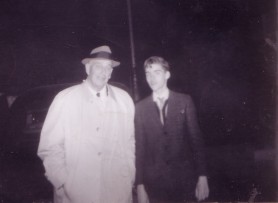|
Unmindful of its past role as host of the 1939-1940 World's
Fair, the park was simply the place to play ball, ice-skate,
swim and picnic during the summers. Then, in 1961, they
closed the park down to build a "World's Fair" to be
opened in 1964. The young Oats, angry that his backyard had been
taken away, would sneak through the heavy gates and play cat-and-mouse
with the Pinkerton guards who patrolled the Fair construction
site. Until one day, in August, 1962, when a severe thunderstorm
literally halted the boy's wanderings in the dangerous construction
site. He was caught, by the "Pinks," up to his knees
in mud!
His eviction by the cops lead to a chance encounter with Robert
Moses who felt bad for the local kid. Moses directed his secretary
to take his name and address so the Fair could send publicity
stuff and so Dave wouldn't, in Moses' words, "come back
here 'till it's open in '64!" From there Dave began a long
involvement with the Fair site; as a "Junior Public Relations
Rep." (unpaid but official as Bill Berns, the
Fair's Vice-President for Public Relations, bestowed the title!)
that allowed Oats an insider's look at the inner workings of
the Fair and, of course, to just enjoy the Fair itself.
World's Fair President Robert Moses and David
Oats outside RM's office in the Administration Building, October,
1965
 |
That chance encounter resulted in a decades-long friendship
with Robert Moses, with Dave even being presented with the World's
Fair flag that had flown over the Administration Building from
1962 to June 3,1967 (the day the Fair handed the park back to
the city). He regularly consulted with Moses about a local person's
view of how to develop the post-Fair park. Forming a local citizen's
action group in 1970 to not only preserve the site's amazing
history but to stem a growing neglect of the park by the city,
Oats created the Flushing Meadows-Corona Park World's Fair
Association and for the next decade it fought the Manhattan-oriented
bureaucracy that allowed the park and it's facilities and environment
to deteriorate.
Along the way there were victories, such as the creation of
a true Queens cultural center in the park, saving Willow Lake
from destruction by developers, the tennis center at the old
Singer Bowl (renamed for Louis Armstrong). But there were losses
and defeats also - the shameful neglect of the New York State
Pavilion and the 1939 Aquacade - and worst of all, the deplorable
neglect, decay and destruction of the 1964 World's Fair Federal
Pavilion.
For over two decades, David held the position of Editor-in-Chief
of the two largest newspapers in Queens writing, along with the
regular stories, on the history and the conditions at Flushing
Meadows. An intense investigative series on a major asbestos
scandal and cover-up by the city at Terrace on the Park in the
late 1990's caused the shutting of the entire building, a million-dollar
clean-up of the structure and the ouster of the long-time lease
holders of the structure and the placement of new management.
The series of articles in the Queens Tribune received
two nominations for the Pulitzer Prize for investigative journalism.
Even after suffering a stroke several years ago, David still
managed to monitor the city's care of the park. He lead an effort
to clean up the last vestige of the old "valley of ashes"
at Willets Point by bringing the 2012 Olympic Stadium there to
complete Moses' vision of Flushing Meadow Park. Most recenly,
he advocated for action to be taken to revive the New York State
Pavilion and publicly called on the Parks Department administration
to take action on conditions that he found inexcusable at Flushing
Meadows.
Of nywf64.com Dave once wrote, "I've
found the site, it's information, graphics and mission of keeping
alive this great event in history for those who were there and
those who were not but love and preserve it, to be unbelievably
rewarding, I have great admiration for all the people who are
a part of sharing and participating in this site. I've reacquainted
with some old friends and found so many delightful and interesting
new ones that I wanted to do here what is not possible in the
cold prose of a book or journalism - and that is to share with
this site what unique perspective I might have on the past, present
and future of this amazing park and open it up to other views
and opinions."
With that, David began writing a series of essays that focused,
not only on the Fairs, but on the legacies of their physical
remnants in the park and how they relate to the present and future
of the park. We called this series "Perisphere's Perspective."
Time was never one of David's best friends and time permitted
him to complete just three essays for this website since Perisphere's
Perspective's inception. They remain as part of the archives
of the site and always will, just as Dave will always remain
a part of the history of the Fair and an inspiration for those
of us who have an interest in the Fair and a desire to see it
preserved at Flushing Meadows.
Thank you, Dave, for your friendship, your insights, your
memories and your passion. You are missed.
|